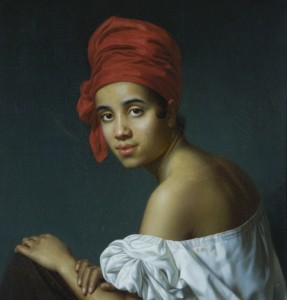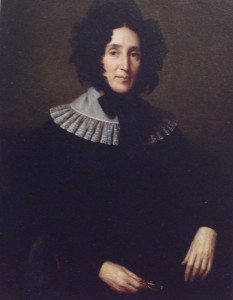Turning her face to meet her viewer’s gaze, Jacques Lucien Amans’ sitter in Creole in a Red Headdress[1] (figure 1) softly smiles.

She wears a brown skirt, red headdress, and a white long-sleeved off-the-shoulder peasant blouse, the profusion of her exposed tan skin adding an air of coquettish sensuality to the painting. The portrayal of this young mixed-race woman visually entices viewers as the bright red hue of her headdress enhances the smooth texture of her café au-lait skin tone. While many of the details behind this compelling image remain a mystery, the sitter’s alluring, unbroken gaze renders her as a subject of much intrigue and speculation, the painting becoming perhaps one of the most illustrious and enigmatic works of antebellum New Orleans.
In order to uncover more information about the motivations behind Creole in a Red Headdress, we must look to its creator. French artist Jacques Guillaume Lucien Amans’ prolific body of work chronicles his time spent as a leading portraitist in New Orleans from the late 1830s through the 1850s.[2] Like many other European artists before him, Amans traveled to the United States and specifically to New Orleans to pursue opportunities for portrait commissions among the planter elite along the Mississippi.
Amans’ Creole in a Red Headdress represents an interesting departure from his standard works. In Amans’ typical portraits of white sitters, such as his Portrait of a Gentlewoman, c. 1842, (figure 2) the artist portrays their figures in three-quarter length facing straight forward. His typical sitters wear rich fashions, highlighting their elevated social status and virtuousness.[3] Thus, the portrait of the Creole in a Red Headdress simultaneously includes definitive features of Amans’ signature style while also utilizing a composition and subject matter inconsistent with his typical portraiture.

In the portrait of the Creole in a Red Headdress, the figure sits with her back toward the audience, as opposed to the typical straight on composition. As she twists around to stare back at the viewers, her blouse falls suggestively low off her shoulder, a direct opposition to the modest high necklines featured in his other portraiture. However, the juxtaposition of her skin tone and bright red tignon—a headscarf worn under penalty of law by women of color in Louisiana—highlights Amans’ signature softer, more colorist approach to the traditional neoclassical style seen in all of his works.
Still, many facets of this portrait remain unsolved, making it unclear as to whether this painting portrays an actual woman or an imagined, eroticized idea of a woman. Because the sitter remains nameless and this painting does not follow the same compositional tenants as Amans’ other portraiture, it might not be considered a portrait at all. In many ways, one might construe Amans’ painting as an exploitative, fantasy-like image of what he believed a mixed-race woman should look like. In New Orleans especially, the view of mixed-race women as both exquisitely beautiful and also sexually available or erotic materialized itself through various pieces of art and literature. While the artistic renderings and theatrical stories of “the Tragic Octoroon”[4] detail the legendary beauty of ill-fated mixed-race women, popular perceptions of mixed-race women deemed their alluring beauty sensuous and licentious. Upon his own exploration of New Orleans, Frenchman Berquin Duvallon characterized, “Mulatto Women [as] full of vanity… with good shapes, polished and elastic skin,” and “[beauty] superior to many of the white girls” (Duvallon, 80).[5] Thus, the intentions behind Amans’ painting could be rooted in these stereotypes.
The Historic New Orleans Collection (HNOC) characterizes the image as “an exotic and mysterious person whose ethnicity, race and even gender are unidentified.” Yes, to some even the sitter’s gender remains an enigma. HNOC director John Lawrence said the subject might be wearing a theatrical costume, so assumptions cannot be made about what the choice of dress represents. “Of course,” Lawrence said, “there’s a bias toward female.” However, to some speculators, the neck seems a bit masculine, leading conspirators to question why the sitter’s upper torso is turned away from the painter, blocking the breasts, and allowing for an androgynous interpretation.[6]
Theories aside, Jacques Amans’ painting remains enticing, visually arresting, and very telling. Amans’ body of work features countless portraits of New Orleans’ white elite whose names appear in many facets of the city’s history (historical documents, street names, etc.). However, it is Amans’ portrait of this unnamed mixed-race woman, posed and painted in a dramatically different light than the others that makes the most lasting impression. In fact, chosen from thousands of other artworks to represent the state’s history of art, this mystery woman graced the cover of A Unique Slant of Light: The Bicentennial History of Art in Louisiana suggesting the painting as an essential piece of Louisiana’s artistic anthology and also as a provocative, enigmatic invitation for viewers to learn more.
R.C.V.
[1] “CREOLE IN A RED HEADDRESS.” THNOC Online Catalog. Williams Research Center, 2010.
[2] Sartisky, Michael, J. Richard Gruber, and John R. Kemp. A Unique Slant of Light: The Bicentennial History of Art in Louisiana. Page 27.
[3] McAlear, Donna. “Portraiture, Landscapes, and Marine Scenes in Nineteenth-Century Louisiana.” Collecting Passions: Highlights from the LSU Museum of Art Collection. Baton Rouge, LA: LSU Museum of Art, 2005. 40+. Print.
[4] Gates, Henry Louis, Jr. “The Octoroon: A Tragic Mulatto Enslaved by 1 Drop.” The Root. Donna Byrd, n.d. Web.
Consulted Works:
- Savage, Kirk. “Chapter 3: Imagining Emancipation.” Standing Soldiers, Kneeling Slaves: Race, War, and Monument in Nineteenth-century America. Princeton, NJ: Princeton UP, 1997. N. pag. Print.
- Boucicault, Dion. The Octoroon, Or, Life in Louisiana (1859). Brooklin, ME: Feedback Theatre & Prospero, 2002. Print.
- Hosmer, Hezekiah L. The Octoroon. New York: Follett, Foster, 1863. Print.
[5] Berquin-Duvallon.. Travels in Louisiana and the Floridas, in the year 1802 : giving a correct picture of those countries. New-York, 1806.
[6] MacCash, Doug. “Historic New Orleans Collection’s Potpourri of Objects Tells Interesting Tales.” NOLA.com. N.p., 24 Aug. 2012.